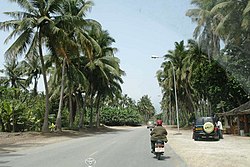After a brief stop at Aden, the steamer sailed for the next largest port by the vast Arabian Sea. Aji Din couldn't wait to set foot on Salalah, the sub-tropical city famed for its frankincense which grew like wild mangroves by its river banks. Ibn Batutta in his rihlah had described his encounter with the ancient frankincense trees in the region of Dhofar, Aji Din recalled. Why, Frankincense had been one of the perfume presented to the infant Isa by the Three Wise Men, he mused.
Darn it, if I had ran away a couple of months earlier, I would have arrived during the Khareef! Now the trees on the jabals had began to shed their leaves, the wadis had dried up and the waterfalls were just a traveller's memory. But no matter, Salalah with its swaying coconut palms, miles and miles of banana and papaya trees would be the closest to his Ummi's home town of Selekoh, Bagan Datoh, where they owned stretches of coconut plantations as far as the eyes could see.
There'll still be the Maqams of the Prophets to visit - the masoleum of an-Nabi Ayub high up among the clouds on the Jabal's peak, the grave of an-Nabi Imran with its arrogant peacocks in its yard and the resting place of an-Nabi Shuaib with its camels' hoof prints intact in the hardened mud caves.
And since Salalah became the capital of Muscat and Oman five years, the Sultan's opulent palace was a sight to behold. Praying at the masjid in Salalah shouldn't be a problem since the Dhofaris were mostly Sunnis, unlike the Ibadis of the Muscat area, he thought. Now, he only had to pick up Shehri or Jeballi, the language of the mountain people of Salalah, when he ventured to the souqs and restaurants in the city. And if luck was on his side, he might even spot a leopard or a hyena when he trekked up the mountainous countryside with his mates!
 |
| Mist-covered meadows during the Khareef, or monsoon season |
 |
| Frankinscense for the bukhoor |
 |
| Al-Mughsayl coastline |


No comments:
Post a Comment